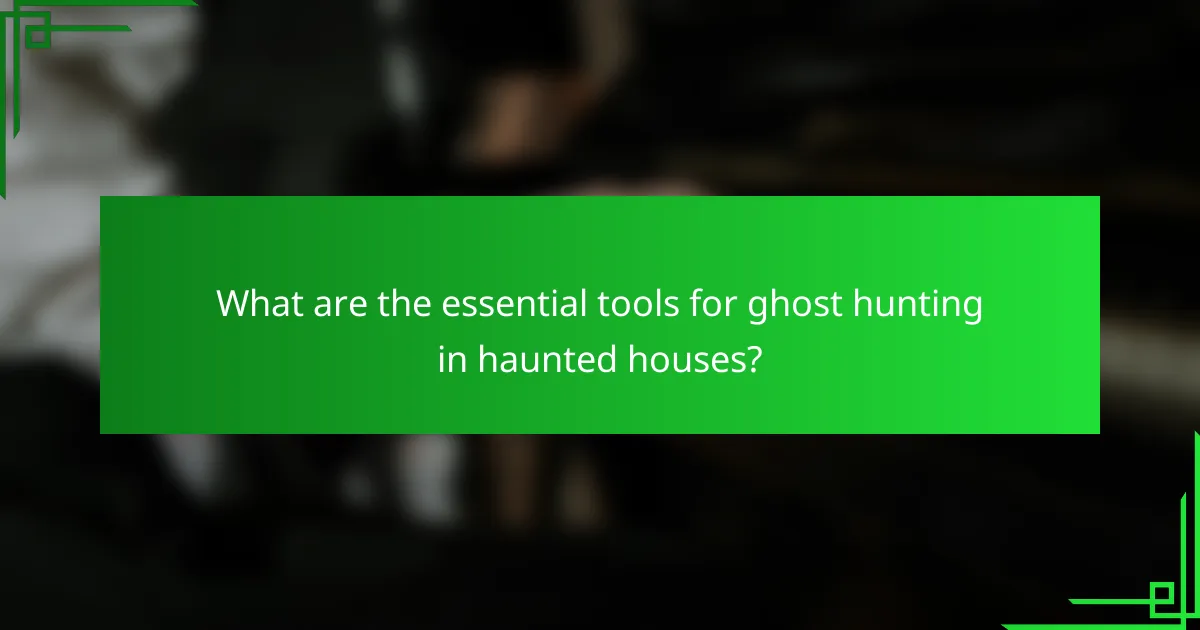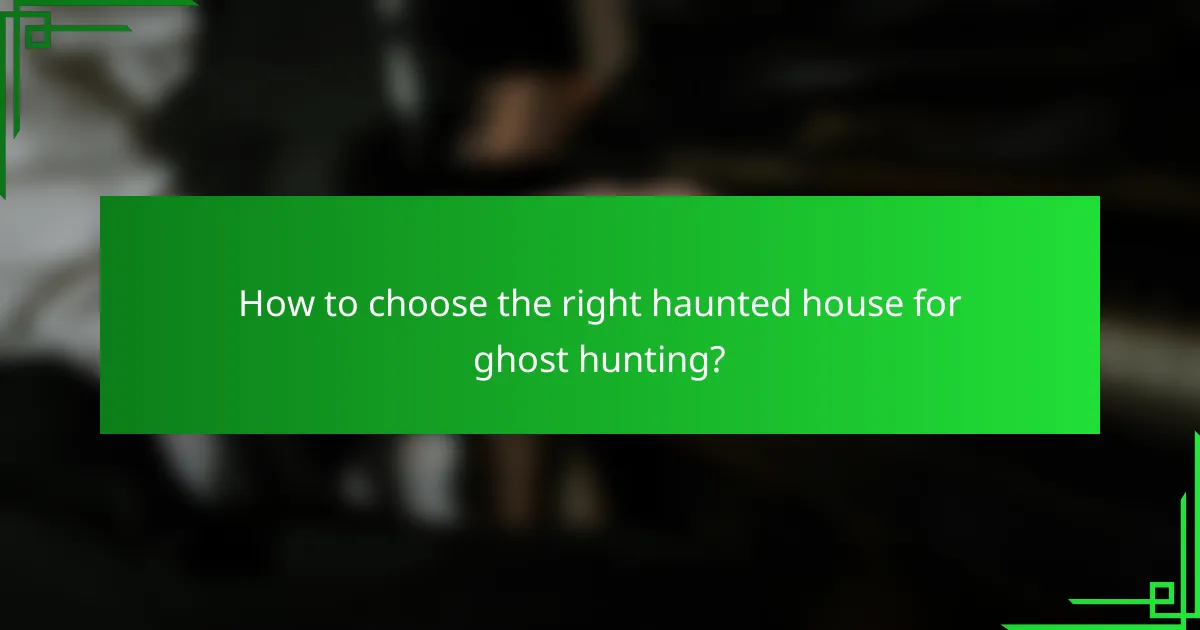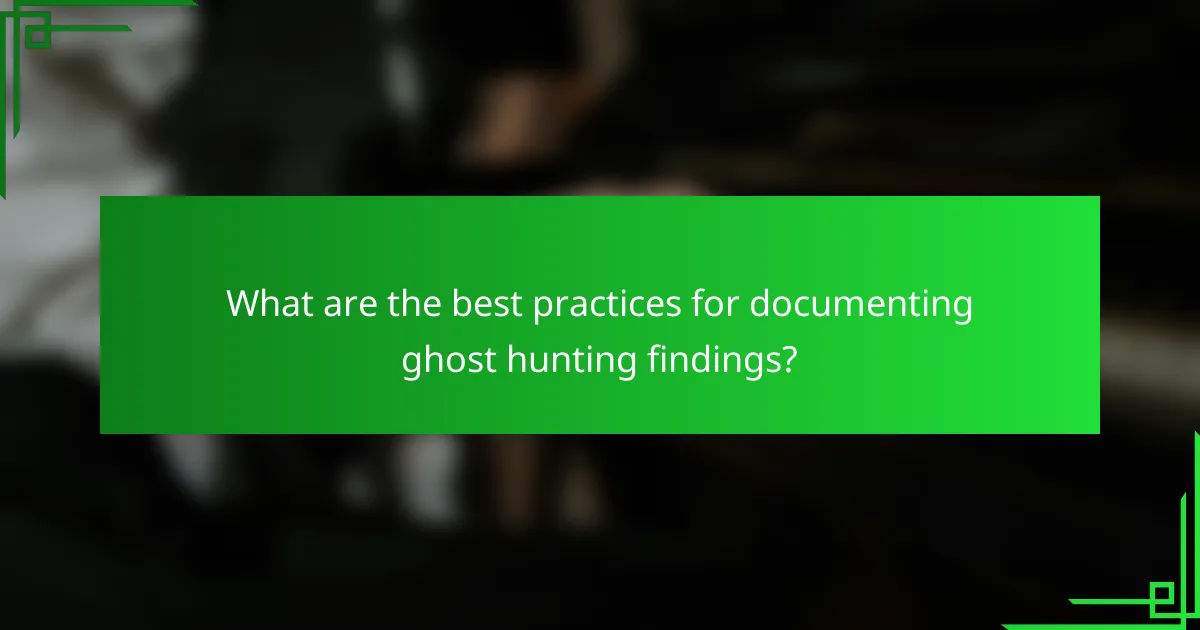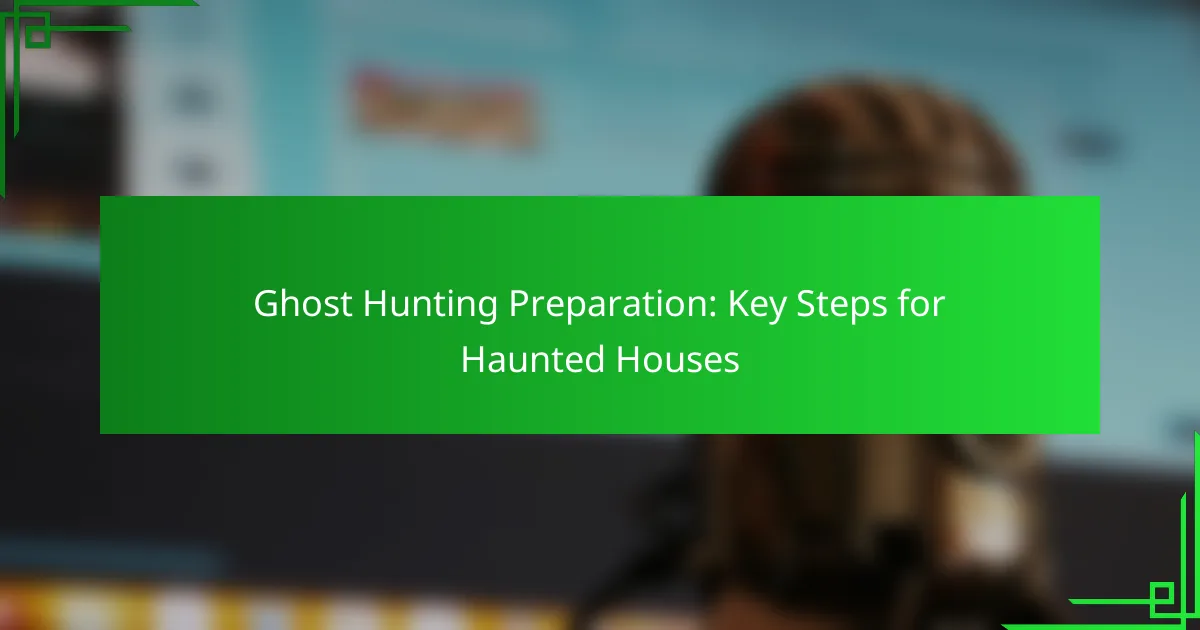Preparing for a ghost hunting expedition in haunted houses requires careful planning and the right tools to enhance your chances of encountering paranormal activity. Essential steps include conducting thorough research, gathering specialized equipment like EMF meters and digital voice recorders, and assembling a skilled team. Prioritizing safety measures is also vital to ensure a secure and successful investigation.

What are the essential tools for ghost hunting in haunted houses?
Essential tools for ghost hunting in haunted houses include devices that help detect paranormal activity and capture evidence. These tools range from electromagnetic field (EMF) meters to digital voice recorders, each serving a unique purpose in the investigation process.
EMF meter
An EMF meter measures electromagnetic fields, which are often associated with paranormal activity. When using this tool, look for unusual spikes in readings, as they may indicate the presence of spirits.
Consider models that offer both digital and analog readings for better accuracy. Keep in mind that common household appliances can also emit EMF, so be aware of your surroundings while measuring.
Digital voice recorder
A digital voice recorder captures audio, making it essential for recording potential spirit voices or Electronic Voice Phenomena (EVP). To maximize effectiveness, use a high-quality device with good sensitivity and a quiet environment.
When conducting a session, ask clear questions and leave pauses for responses. Review recordings in a quiet space to identify any unexplained sounds that may indicate paranormal activity.
Infrared camera
Infrared cameras are used to capture images in low-light conditions, making them ideal for ghost hunting in dark environments. These cameras can reveal temperature variations and anomalies that the naked eye might miss.
Choose a camera with good resolution and infrared capabilities. Be cautious of reflections and other environmental factors that could lead to misinterpretations of the images captured.
Spirit box
A spirit box is a device that scans radio frequencies to communicate with spirits. It allows for real-time interaction, as spirits may manipulate the audio to form words or phrases.
Use the spirit box in quiet areas and ask clear, direct questions. Be prepared for random noise and static, and focus on coherent responses that may emerge during your session.
Flashlight
A reliable flashlight is crucial for navigating dark haunted houses. Opt for a durable, high-lumen flashlight to ensure visibility in low-light conditions.
Consider carrying extra batteries, as ghost hunting can often lead to extended periods in the dark. Avoid using your phone’s flashlight, as it may not provide sufficient light and can drain your battery quickly.

How to prepare for a ghost hunting expedition?
Preparing for a ghost hunting expedition involves thorough research, gathering the right equipment, assembling a capable team, and planning an effective investigation schedule. Each step is crucial to enhance the chances of a successful and safe experience in potentially haunted locations.
Research the location
Understanding the history and background of the haunted location is vital. Look for any documented paranormal activity, local legends, and previous investigations to gain insights into what to expect. Websites, books, and local archives can provide valuable information.
Consider visiting the site during the day to familiarize yourself with the layout and any potential hazards. Take note of areas that are reported to be more active, as this can guide your investigation strategy.
Gather necessary equipment
Essential ghost hunting equipment includes EMF meters, digital voice recorders, infrared cameras, and night vision gear. Each tool serves a specific purpose, such as detecting electromagnetic fields or capturing audio evidence of paranormal activity.
Before heading out, ensure all equipment is in working order and fully charged. It’s also wise to bring extra batteries and backup devices to avoid interruptions during the investigation.
Assemble a team
Forming a reliable team is crucial for a successful ghost hunting expedition. Look for individuals who share a genuine interest in the paranormal and possess complementary skills, such as technical expertise or investigative experience.
Establish clear roles for each team member, such as a lead investigator, equipment manager, and note-taker. This organization helps streamline the investigation and ensures that all aspects are covered efficiently.
Plan the investigation schedule
Creating a detailed schedule for the ghost hunting expedition helps maximize the time spent at the location. Plan for peak activity times, often late at night, and allocate specific time slots for different areas of the site.
Include breaks in the schedule to allow team members to regroup and discuss findings. Flexibility is key, as unexpected events may require adjustments to the plan. Aim to keep the investigation focused yet adaptable to new discoveries.

What safety measures should be taken during ghost hunting?
Safety measures during ghost hunting are crucial to ensure the well-being of all participants. These precautions include establishing communication protocols, carrying first aid supplies, and familiarizing yourself with the haunted house layout.
Establish a communication plan
A solid communication plan is essential for coordinating activities and ensuring everyone’s safety during ghost hunting. Designate a leader to manage the group and establish a method for regular check-ins, such as walkie-talkies or mobile phones.
Before entering the haunted house, agree on specific meeting points in case anyone gets separated. This helps maintain group cohesion and allows for quick responses in emergencies.
Bring first aid supplies
Having first aid supplies on hand is vital for addressing any injuries that may occur during ghost hunting. A basic first aid kit should include band-aids, antiseptic wipes, gauze, adhesive tape, and any personal medications needed by team members.
Consider including items for specific situations, such as flashlights for minor injuries in dark areas or a whistle to signal for help. Regularly check and restock your first aid kit to ensure it is always ready for use.
Know the haunted house layout
Understanding the layout of the haunted house can prevent accidents and enhance safety. Before the investigation, study blueprints or maps of the building to identify exits, staircases, and potential hazards like unstable floors or broken glass.
During the exploration, keep a copy of the layout handy and ensure everyone in the group is aware of it. This knowledge allows for quick navigation and can be crucial in emergencies when time is of the essence.

How to choose the right haunted house for ghost hunting?
Choosing the right haunted house for ghost hunting involves considering its historical significance, feedback from other hunters, and accessibility. Each of these factors can greatly influence the quality of your ghost hunting experience.
Check historical significance
Investigating the historical significance of a haunted house can enhance your ghost hunting experience. Look for locations with a rich history of paranormal activity, such as sites associated with tragic events or notorious figures.
Research local archives or historical societies to gather information about the house’s past. This context can help you understand the types of spirits you might encounter and the stories behind them.
Read reviews from other hunters
Reviews from fellow ghost hunters provide valuable insights into the haunted house’s reputation. Check online forums, social media groups, and dedicated ghost hunting websites for firsthand accounts of experiences.
Pay attention to recurring themes in the reviews, such as the types of phenomena reported or the overall atmosphere of the location. This can help you gauge whether the house aligns with your interests and expectations.
Assess accessibility and permissions
Before planning your ghost hunting trip, ensure the haunted house is accessible and that you have the necessary permissions. Some locations may require advance booking or specific permits to conduct investigations.
Check the hours of operation and any associated fees, as these can vary widely. Additionally, consider the physical accessibility of the site, especially if you plan to explore multiple levels or outdoor areas.

What are the best practices for documenting ghost hunting findings?
Documenting ghost hunting findings effectively involves using various methods to capture evidence and experiences. This ensures that your observations are credible and can be shared with others for further analysis.
Use video and audio recordings
Video and audio recordings are essential tools for documenting ghost hunting findings. They provide visual and auditory evidence that can support claims of paranormal activity. Use high-quality cameras and microphones to capture clear footage and sound, ensuring you have enough storage space for lengthy investigations.
When recording, focus on areas where activity is reported. Consider using night vision cameras for low-light conditions and external microphones to capture sounds from a distance. Always check local laws regarding recording in private properties to avoid legal issues.
Take detailed notes
Taking detailed notes during your ghost hunting sessions is crucial for accurate documentation. Write down the date, time, location, and environmental conditions, as well as any personal experiences or sensations felt during the investigation. This context can help in analyzing the findings later.
Use a structured format for your notes, such as bullet points or headings for different types of observations. Include specific details about any unusual occurrences, such as temperature changes or unexplained noises, to provide a comprehensive account of the event.
Share findings with the community
Sharing your ghost hunting findings with the community can enhance your credibility and foster collaboration. Present your evidence on forums, social media, or local ghost hunting groups to engage with others who have similar interests. This can lead to valuable feedback and new insights.
When sharing, be transparent about your methods and findings. Consider creating a summary report that includes your recordings, notes, and any conclusions drawn. This not only helps others learn from your experiences but also contributes to the broader understanding of paranormal investigations.
